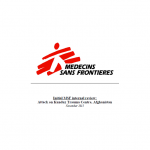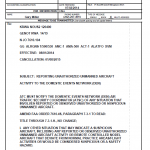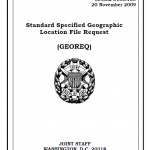First responding officers should be aware of suspicious factors that may indicate a possible terrorist threat. These factors should be considered collectively in assessing a possible threat. This quick reference guide is intended to provide practical information for line officers but may not encompass every threat or circumstance. State and local law enforcement may contact their local FBI field office or resident agency for additional assistance.
134 search results for "cell phone"
Multi-National Corps Iraq
Multi-National Corps Iraq Counter-IED Smart Book 2008
All personnel are to be moved away from the suspect item. Mark your location and note the direction and distance to the device. Move to a minimum distance of 300 meters from the suspect item. The Convoy Commander or Patrol Leader at the scene makes the decision on how large an area to clear based on METT-TC. Detonation may be imminent if the device was armed before being located. Personnel should make maximum use of hard cover, ensuring they are out of the direct Line of Site (LOS) from the suspect area to cleared positions. If cover cannot be obtained, maximize distance from the device.
California
Violence Reduction: Intelligence Led Policing
ILP: Products
• Strategic Intelligence: Helps decision makers define a vision and hold managers accountable.
• Operational Intelligence: Gives managers adequate information to develop operational plans and adjust resources.
• Tactical Intelligence: Allows line personnel the ability to focus their efforts on solving problems and targeting the right people.
Nevada
Las Vegas Metropolitan Police Department October 2017 Mass Shooting Final Report
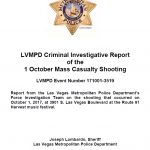
As Engineer Schuck walked up the hallway of the 100 Wing, he observed Security Officer Campos poke his head out of an alcove. Engineer Schuck then heard rapid gunfire coming from the end of the 100 Wing hallway that lasted approximately 10 seconds. When the gunfire stopped, he heard Security Officer Campos tell him to take cover. Engineer Schuck stepped into an alcove and gunfire again erupted down the hallway coming from Room 32-135. The gunfire lasted a few seconds then stopped. The gunfire started again after a brief pause, but Engineer Schuck believed it was directed outside and not down the hallway. Meanwhile, inside the Las Vegas Village over 50 Las Vegas Metropolitan Police Department (LVMPD) personnel were on overtime assignments for the Route 91 Harvest music festival being held at the Las Vegas Village venue. The initial gunshots were heard on an officer’s body worn camera (BWC). As the suspect (Stephen Paddock) targeted the concertgoers with gunfire, officers quickly determined they were dealing with an active shooter and broadcast the information over the radio.
Drug Enforcement Administration
DEA Drug Slang Code Words 2018
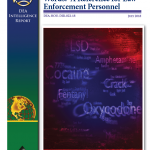
This Drug Enforcement Administration (DEA) Intelligence Report contains new and updated information on slang terms and code words from a variety of law enforcement and open sources, and serves as an updated version to the product entitled “Drug Slang Code Words” published by the DEA in May 2017. It is designed as a ready reference for law enforcement personnel who are confronted with hundreds of slang terms and code words used to identify a wide variety of controlled substances, designer drugs, synthetic compounds, measurements, locations, weapons, and other miscellaneous terms relevant to the drug trade. Although every effort was made to ensure the accuracy and completeness of the information presented, due to the dynamics of the ever-changing drug scene, subsequent additions, deletions, and corrections are inevitable. Future addendums and updates to this report will attempt to capture changed terminology to the furthest extent possible.
Nevada
Las Vegas Metropolitan Police Department October 2017 Mass Shooting Preliminary Report
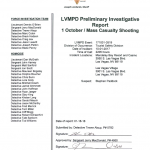
On October 1, 2017, over 22,000 people came together to enjoy a country music festival in Las Vegas, Nevada. On the third and final night of the festival, a lone gunman opened fire into the crowd from the 32nd floor of the Mandalay Bay Resort and Casino. The gunfire continued for over ten minutes, resulting in the deaths of 58 innocent concert goers and injuring more than 700. With law enforcement closing in, the suspect took his own life.
Delaware, Intelligence Fusion Centers
(U//FOUO) Delaware Fusion Center: Officer Safety Smart Watches
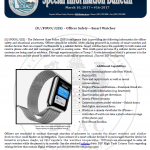
The Delaware State Police (DSP) Intelligence Unit is providing the following information for officer safety and situational awareness. Officers should be mindful, when placing prisoners in custody, of smart watches and similar devices that can connect via Bluetooth to a cellular device. Smart watches have the capability to both make and receive phone calls and text messages, as well as erasing same. This could cause an issue if a cellular device and it’s contents are being used as evidence. Through experimentation at Troop 7, it was determined that if a prisoner is in the detention area and the phone is seized, the watch could still be operational.
New Jersey
New Jersey Office of Homeland Security Guide: Anarchist Extremists – Antifa
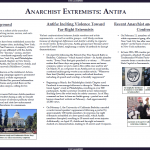
Self-described Antifa groups have been established across the United States and in several major cities, including New York, Philadelphia, Chicago, and San Francisco. A majority of New Jersey-based anarchist groups are affiliated with the Antifa movement and are opposed to “fascism,” racism, and law enforcement. Antifa groups coordinate regionally and have participated in protests in New York City and Philadelphia. There are three loosely organized chapters in New Jersey, known as the North Jersey Antifa, the South Jersey Antifa, and the HubCity Antifa New Brunswick (Middlesex County).
Drug Enforcement Administration
DEA Drug Slang Code Words
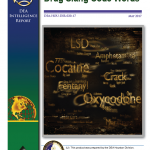
This Drug Enforcement Administration (DEA) Intelligence Report contains information from a variety of law enforcement and open sources. It is designed as a ready reference for law enforcement personnel who are confronted by many of the hundreds of slang terms used to identify a wide variety of controlled substances, designer drugs, and synthetic compounds. Every effort has been made to ensure the accuracy and completeness of the information presented. However, due to the dynamics of the ever-changing drug scene, subsequent additions, deletions, and corrections are inevitable. Further addendums to this report will attempt to capture changed terminology, to the extent possible. This compendium of drug slang terms has been alphabetically ordered, and identifies drugs and drug categories in English and foreign language derivations.
Corporate
AT&T Analytical Services for Government Agencies Model Statement of Work
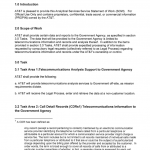
AT&T shall provide certain data and reports to the Government Agency, as specified in section 3.0 Tasks. The data that will be provided to the Government Agency is limited to telecommunications information and records and analysis thereof. In addition to the items provided in section 3.0 Tasks, AT&T shall provide expedited processing of information requested by compulsory legal requests (collectively referred to as Legal Process) regarding telecommunications information and records under the AT&T’s ownership or control.
Federal Bureau of Investigation
FBI Cyber Division Bulletin: KeySweeper Wireless Keystroke Logger Disguised as USB Device Charger
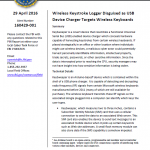
KeySweeper is a covert device that resembles a functional Universal Serial Bus (USB) enabled device charger which conceals hardware capable of harvesting keystrokes from certain wireless keyboards. If placed strategically in an office or other location where individuals might use wireless devices, a malicious cyber actor could potentially harvest personally identifiable information, intellectual property, trade secrets, passwords, or other sensitive information. Since the data is intercepted prior to reaching the CPU, security managers may not have insight into how sensitive information is being stolen.
Technical Details
Department of Homeland Security, Federal Bureau of Investigation, National Counterterrorism Center
(U//FOUO) DHS-FBI-NCTC Bulletin: Tactics, Techniques, and Procedures Used in November 2015 Paris Attacks
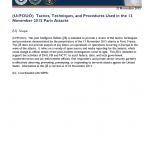
This Joint Intelligence Bulletin (JIB) is intended to provide a review of the tactics, techniques, and procedures demonstrated by the perpetrators of the 13 November 2015 attacks in Paris, France. This JIB does not provide analysis of any follow-on operations or operations occurring in Europe in the wake of the attacks. It relies on a variety of open source and media reporting for the analysis, which could change as official details of the post-incident investigations come to light. This JIB is intended to support the activities of DHS, FBI and NCTC to assist federal, state, and local government counterterrorism and law enforcement officials, first responders, and private-sector security partners in effectively deterring, preventing, preempting, or responding to terrorist attacks against the United States.
Afghanistan
Medecins Sans Frontieres Initial Review of U.S. Attack on Kunduz Trauma Centre, Afghanistan
News
Comments on Reddit Led to Virginia Fusion Center Warning on Protesters Attacking Emergency Vehicles
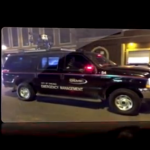
A bulletin issued in December 2014 by the Virgina Fusion Center (VFC) warned law enforcement and first responders that emergency vehicles could be targeted by violent protesters seeking to retaliate against the perceived surveillance of their activities. The bulletin, which is titled “Malicious Activists May Promote Harm to Emergency Management Vehicles Observed During Violent Protests,” draws its conclusion that “violent or malicious activity” could be directed toward emergency vehicles “operating near protest areas” based primarily upon comments to a post on Reddit and a protest guide posted anonymously on Pastebin.
Intelligence Fusion Centers, Virginia
(U//FOUO) Virginia Fusion Center Bulletin: Malicious Activists May Promote Harm to Emergency Vehicles
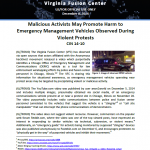
The Virginia Fusion Center (VFC) has observed via open sources that actors affiliated with the Anonymous hacktivist movement released a video which purportedly identifies a Chicago Office of Emergency Management and Communications (OEMC) vehicle as a tool for law enforcement wiretapping efforts by police and fusion center personnel in Chicago, Illinois. The VFC is sharing this information for situational awareness, as emergency management vehicles operating near protest areas may be targeted by precipitating violent or malicious activity.
Department of Justice
Bureau of Justice Assistance Managing Large-Scale Security Events Planning Guide
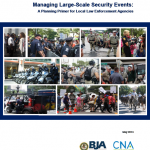
Large-scale events provide local governments with a number of valuable opportunities, including increasing revenue, revitalizing a city, and providing an increased sense of community. With these benefits comes greater responsibility for local law enforcement to ensure the public’s safety. When law enforcement executives are tasked with managing a large event, they can maximize their efforts by learning from other agencies and adopting proven practices. Too often, however, past lessons learned are not documented in a clear and concise manner. To address this information gap, the U.S. Department of Justice’s Bureau of Justice Assistance worked in partnership with CNA to develop this Planning Primer.
Federal Aviation Administration
FAA Notice: Reporting Unauthorized Unmanned Aircraft Activity to the Domestic Events Network
Intelligence Fusion Centers, Pennsylvania
(U//FOUO) Pennsylvania Fusion Center Bulletin: Targeting First Responders
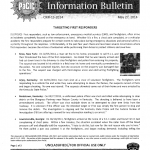
First responders, such as law enforcement, emergency medical services (EMS), and firefighters, often arrive at incidents completely focused on the emergency at hand. Whether it is a fire, a chest pain complaint, or a vehicular accident, the first responders prepare for certain events to take place during emergency situations and personal safety is a priority throughout the response. Unfortunately, in the past few years there are have been several occurrences where first responders became the victims of ambushes while performing their duties to protect citizens and save lives.
District of Columbia, Intelligence Fusion Centers
(U//FOUO) Washington D.C. Fusion Center Bulletin: Nationwide Fuel Theft Trend
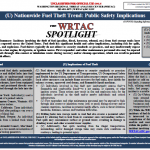
Incidents involving the theft of fuel (gasoline, diesel, kerosene, ethanol, etc.) from fuel storage tanks have been reported across the United States. Fuel theft has significant health and safety implications, including risk for spills, fires, and explosions. Fuel thieves typically do not adhere to security standards or practices, and may inadvertently expose fuel to a hot engine, lit cigarette, or ignition source. First responders and other maintenance personnel also may be exposed to fuels through skin contact or inhalation routes during recovery and/or cleanup operations, which can result in potential health effects.
Department of Justice
National Institute of Justice Through-the-Wall Sensors Best Practices for Law Enforcement
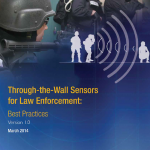
The National Institute of Justice (NIJ) Sensor, Surveillance, and Biometric Technologies (SSBT) Center of Excellence (CoE) has undertaken a best practices report of through-the-wall sensor (TTWS) devices for operation by law enforcement and first responder agencies in the United States. These devices use a form of radar to detect movement behind barriers. The ability to sense the presence of individuals through common building materials can be useful during rescue operations, law enforcement operations and other tactical scenarios. This report provides advice, tactics and information related to the use of TTWS in operational settings. The information provides law enforcement individuals and organizations with a better understanding of the capabilities and limitations of available TTWS equipment. When put into practice, an agency can make the most of the technology and improve the outcome and safety of operational scenarios in which it is deployed. The best practices report focuses on the use of commercially available TTWS devices suitable for law enforcement or emergency response applications.
U.S. Army
Restricted U.S. Army Special Forces Handbook for the Fingerprint Identification System
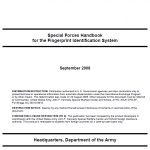
Special Forces (SF) Soldiers use various biometric identification systems in SF operations. Biometric applications are fundamental to a wide array of SF operational activities, including, but not limited to, the growing field of SF sensitive site exploitation (SSE) and the range of unit protection activities. SSE applications include the identification of enemy personnel and cell leaders in a counterinsurgency (COIN) environment following tactical operations, particularly during direct action missions. Unit protection applications include maintaining databases on the identities of both United States Government (USG) and local national personnel.
Department of Justice
Social Media and Tactical Considerations For Law Enforcement
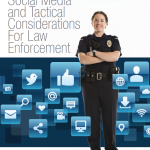
The use of social media is a relatively new phenomenon in policing. Development of formal policy on social media is generally lagging behind practice. A variety of legal, civil rights, and privacy-related issues regarding social media have been raised, but these issues have not yet been settled by legislatures or resolved in the courts. Social Media and Tactical Considerations for Law Enforcement summarizes discussions at a national conference of police executives on these issues, and analyzes the experiences of selected law enforcement agencies in the United States, Canada, and the United Kingdom that have shown leadership in advancing the use of social media for various purposes. Police agencies can use social media to facilitate two-way communications with the public to disseminate information, manage political demonstrations and other major events, obtain intelligence about “flash mobs” or rioting, and investigate crimes.
Joint Chiefs of Staff
(U//FOUO) Joint Chiefs of Staff Manual: Standard Specified Geographic Location File Request (GEOREQ)
In the Press
An incomplete list of news articles, scholarly articles and academic reports that cite or utilize information from this website as source material. Print and Online Donald Trump Signs Authorization for Border Troops Using Lethal Force as Migrant Caravan Approaches, Document…
Federal Bureau of Investigation
FBI Bomb Data Center Bulletin: The Bomb Threat Challenge
As we enter an era in which the administration of law enforcement becomes more complicated, greater challenges are thrust not only upon police officials, but also upon the community at large. The bomb threat is one such challenge. The bomber has a distinct advantage over other criminals because he can pick his time and place from afar, and use the bomb threat as a weapon to achieve his criminal objectives. This bulletin has been prepared in order to provide law enforcement and public safety agencies with a working base from which to establish their own bomb threat response capability; and to enable these same agencies, when called upon by potential bomb or bomb threat targets in the business community, to offer assistance in developing guidelines for a bomb threat response plan.

